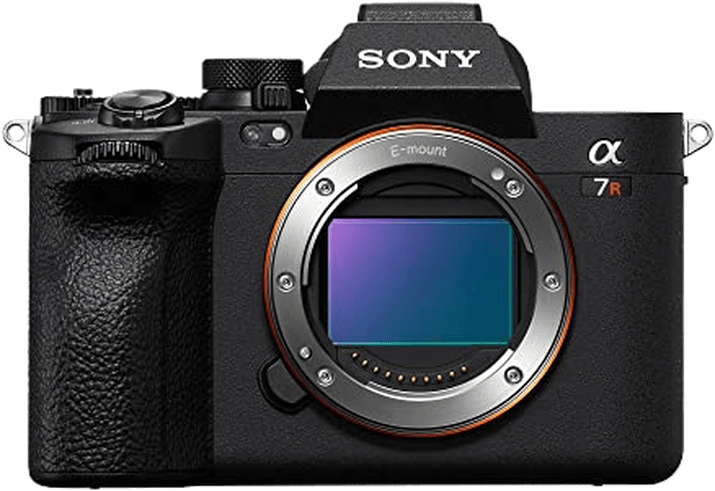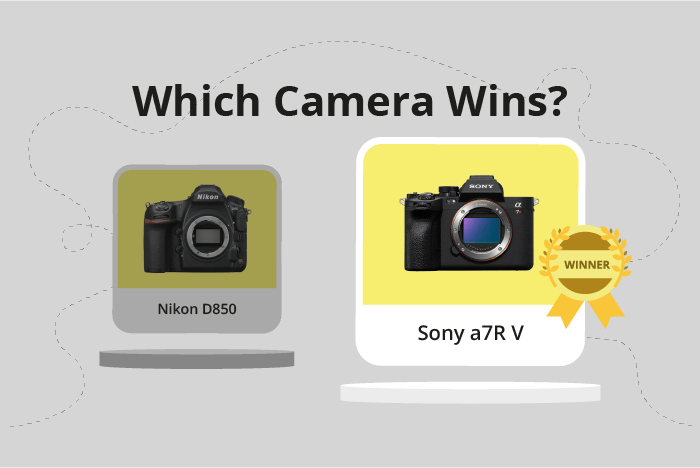Nikon D850 vs Sony a7R V Comparison
Nikon D850

Sony a7R V

The Sony a7R V emerges as the winner with a score of 85/100, outperforming the Nikon D850, which scores 82/100. Both cameras share common specifications, such as being released in the 2010s and having a launch price above $3000.
The Sony a7R V excels with its mirrorless design, making it lighter at 723g and more compact with dimensions of 131 x 97 x 82mm. In contrast, the Nikon D850 is a DSLR camera, weighing 1005g and measuring 146 x 124 x 79mm.
However, the Nikon D850 has its advantages, primarily its lower launch price of $3300 compared to the Sony a7R V’s $3999.
Taking these points into account, the Sony a7R V’s higher score reflects its superior design and portability, while the Nikon D850 remains a more affordable option.
Nikon D850 vs Sony a7R V Overview and Optics
The Sony a7R V wins the optics comparison with a score of 85/100, outperforming the Nikon D850, which scores 79/100. Both cameras share several specifications, including a CMOS sensor, full-frame sensor size, and compatibility with their respective brand’s lens mounts – Nikon F FX for the D850 and Sony FE for the a7R V.
The Sony a7R V’s superior performance stems from its higher megapixel count of 61, compared to the D850’s 45.7 megapixels. Additionally, the a7R V boasts a faster shooting speed of 10 frames per second, while the D850 captures at 7 fps. The a7R V also features image stabilization, which the D850 lacks. These factors contribute to the a7R V’s higher score and better overall performance in optics.
On the other hand, the Nikon D850 has a notable advantage in its DXOMARK sensor score, achieving a perfect 100, whereas the Sony a7R V scores 94. The D850’s sensor, combined with its Expeed 5 processor, delivers exceptional image quality. However, this advantage does not outweigh the a7R V’s superior specifications in other areas.
Considering each camera’s strengths and weaknesses, the Sony a7R V emerges as the better option for photographers seeking top-notch optics. Its higher megapixel count, faster shooting speed, and image stabilization make it a more versatile and capable choice. Meanwhile, the Nikon D850 remains a strong contender, particularly for those who prioritize sensor performance and image quality above other factors.
Nikon D850 vs Sony a7R V Video Performance
The Sony a7R V emerges as the winner in the video capabilities comparison, scoring a perfect 100/100, while the Nikon D850 trails behind with a score of 70/100. Both cameras share common features such as 4K video resolution, time-lapse functionality, and a maximum video frame rate of 30fps.
The Sony a7R V excels in its video capabilities, offering an outstanding 8K max video resolution, which is double the resolution provided by the Nikon D850. Furthermore, the Sony a7R V boasts a maximum video dimension of 7680 x 4320, significantly larger than the Nikon D850’s 3840 x 2160. The Sony camera also supports a higher maximum video frame rate at 120fps, allowing for smoother and more detailed slow-motion footage.
Although the Nikon D850 does not outperform the Sony a7R V in any specific video feature, it is still a competent camera with a 4K video resolution and time-lapse functionality. Its maximum video frame rate of 30fps is suitable for most general video recording purposes. However, it does not match the Sony a7R V’s superior features.
The Sony a7R V is the clear choice for those prioritizing video capabilities, with its impressive 8K resolution, larger video dimensions, and higher frame rate. On the other hand, the Nikon D850 remains a viable option for those seeking a more budget-friendly camera with decent video features, though it does not compete with the Sony a7R V’s advanced offerings.
Nikon D850 vs Sony a7R V Features and Benefits
The Nikon D850 and the Sony a7R V both receive a feature score of 87/100, making them equally strong contenders in terms of their specifications. They share a number of common features, including a 3.2-inch touchscreen, WiFi, and Bluetooth connectivity. Neither camera has GPS capabilities.
The Nikon D850 has a slight advantage in screen resolution, boasting 2,359,000 dots as opposed to the Sony a7R V’s 2,100,000 dots. This results in a crisper and clearer display on the Nikon D850, allowing for greater precision when reviewing images and navigating menus.
On the other hand, the Sony a7R V offers a flip screen, which the Nikon D850 lacks. This feature enhances the camera’s versatility, particularly for photographers who frequently shoot from challenging angles or require a discreet shooting position, such as in street photography or when capturing wildlife.
While both cameras excel in their respective areas, the Nikon D850’s superior screen resolution may appeal to photographers who prioritize image clarity and detail. Conversely, the Sony a7R V’s flip screen makes it a more adaptable choice for those who need flexibility in their camera setup.
Ultimately, the decision between the Nikon D850 and the Sony a7R V will depend on individual preferences and requirements. Both cameras are strong contenders with similar feature scores, and photographers can confidently choose either model based on their specific needs.
Nikon D850 vs Sony a7R V Storage and Battery
The Nikon D850 outperforms the Sony a7R V in storage and battery, scoring 84/100 compared to Sony’s 73/100. Both cameras have two memory card slots, but the D850 accepts SD/SDHC/SDXC (UHS-II compatible) and XQD cards, while the a7R V uses SD/SDHC/SDXC and CFexpress Type A cards.
The D850’s battery life is significantly better, offering 1840 shots per charge with its EN-EL15a battery, compared to the a7R V’s 530 shots using the NP-FZ100 battery. This difference makes the Nikon D850 a more reliable option for extended periods of shooting.
However, the Sony a7R V does have the advantage of USB charging, which the Nikon D850 lacks. This feature can be beneficial for photographers who need to recharge on the go or in situations where a dedicated battery charger is not available.
Considering these factors, the Nikon D850 proves to be superior in terms of storage and battery life, making it the better choice for longer shooting sessions. The Sony a7R V, on the other hand, offers the convenience of USB charging, which may be a deciding factor for some photographers.
Nikon D850 vs Sony a7R V – Our Verdict
Are you still undecided about which camera is right for you? Have a look at these popular comparisons that feature the Nikon D850 or the Sony a7R V:

